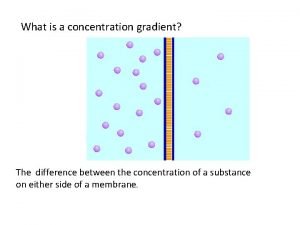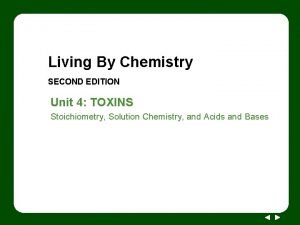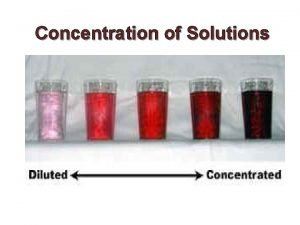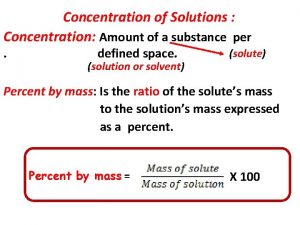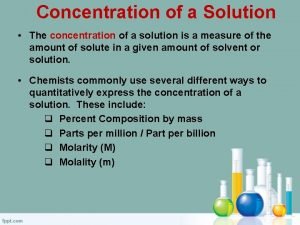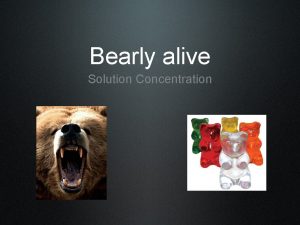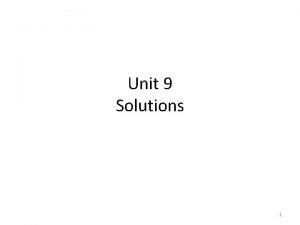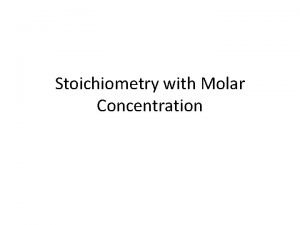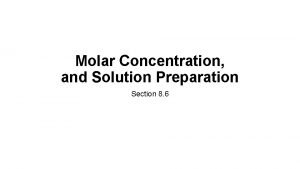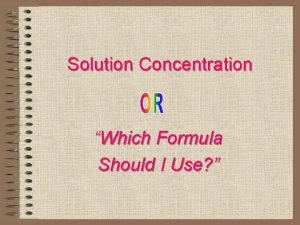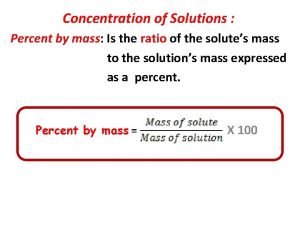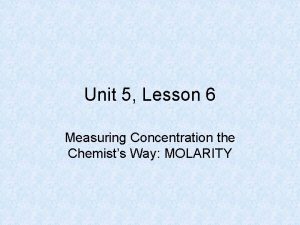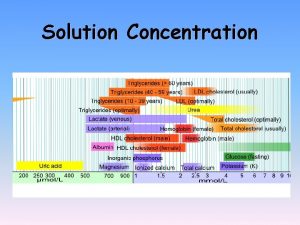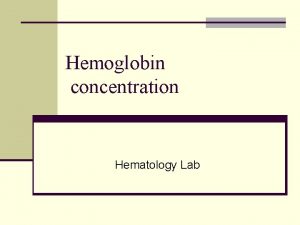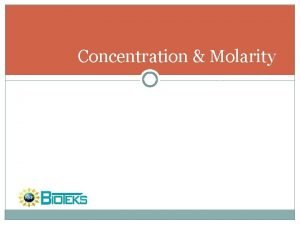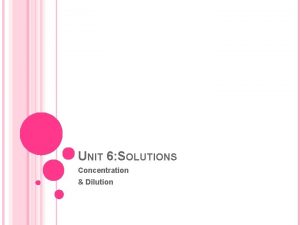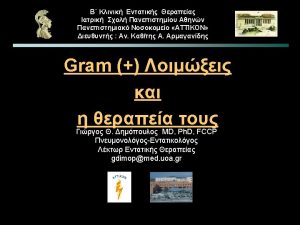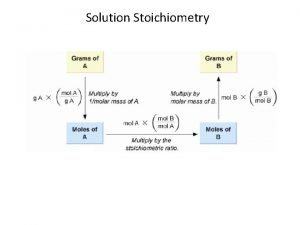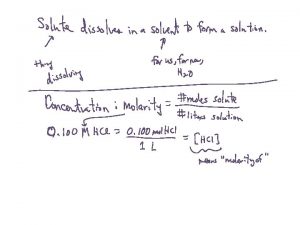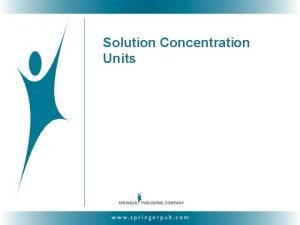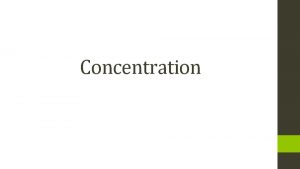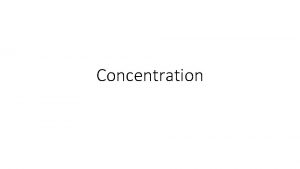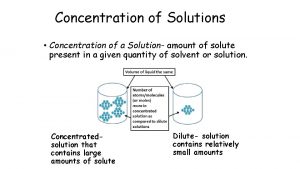12 4 NOTES Solution Concentration II Solution Concentration

















- Slides: 17

12. 4 NOTES Solution Concentration

• II. Solution Concentration • A. Expressing concentration • Many different ways of giving the concentration of a solution: • concentration is a measure of solute in a given amount of solvent • qualitative - concentrated (large amounts of solute) vs. dilute (small amounts of solute); • quantitative – numbers • B. Molarity – the most common unit in the lab • 1. Determining molarity • M = moles solute L of solution

• Examples: a. 47. 5 grams of Na. OH are dissolved in enough water to make 1500 m. L of solution. M? • 47. 5 g ( 1 mol Na. OH) = 1. 19 mol = 0. 79 M • 40. 0 g 1. 5 L •

• b. 1. 78 g Ca. Br 2 are dissolved in 200. m. L of solution. Molarity? • 1. 78 g (1 mol Ca. Br 2) = 0. 00890 mol = 0. 0445 M • 200. g 0. 200 L

• 2. Preparing molar solutions to make solution, dissolve solute in volume smaller than desired final volume (b/c solute particles will also take up space) and then add solvent to raise the volume to the desired value; • If M = moles solute , then M x L = moles solute, or MV = mol (V is in L) • L solution

• Examples: a. How many grams of Ca. Br 2 are needed to prepare 2. 5 L of a 1. 0 M solution? • 2. 5 L x 1. 0 M = 2. 5 mol (199. 9 g Ca. Br 2) = 500 g • 1 mol

• b. What mass of Na. OH is present in 500. m. L of a 0. 75 M solution? • 0. 500 L x 0. 75 M = 0. 38 mol (40. 0 g Na. OH) = 15. g • 1 mol

• c. How many grams of HCl are dissolved in 350. 0 m. L of a 2. 0 M solution? • 0. 3500 L x 2. 0 M = 0. 70 mol (36. 5 g HCl) = 26 g • 1 mol

• 3. Diluting solutions • When diluting a solution, the number of moles of solute has not been changed. Therefore, we can use the relationship M 1 V 1 = M 2 V 2. Since volume appears on both sides of the equation, V does not have to be in liters.

• Examples: a. What volume of 6. 0 M HCl is needed to make 1. 5 liters of 1. 0 M solution? • (6. 0)(V) = (1. 5)(1. 0) • V = 0. 25 L •

• b. If you dilute 25. 0 m. L of 12. 0 M HCl to 500. m. L of solution, what is the new molarity? • (25. 0)(12. 0) = (500. )(M) • 0. 60 = M

• C. Molality • The molarity of a solution changes with temperature as the solution expands or contracts. Molality, which is a ratio of moles of solute to grams of solvent, does NOT change with temperature. • • Molality (m) = moles of solute • kilogram of solvent

• Examples: a. What is the molality if 35. 6 grams of Na. OH is dissolved in 200. 0 grams of water? • 35. 6 g (1 mol Na. OH) = 0. 890 mol = 4. 45 m • 40. 0 g 0. 2000 kg

• b. What is molality of a solution if 2. 3 grams of KNO 3 is dissolved in 50. 0 grams of water? • 2. 3 g (1 mol KNO 3) = 0. 023 mol = 0. 46 m • 101. 1 g 0. 050 kg •

• D. Mole Fraction • Mole fraction is denoted by an X. Xa = moles of a • Total moles = na na + nb

• Examples: a. What is the mole fraction of CH 3 OH if 20. 0 grams are mixed into 100. grams of water? • CH 3 OH = 20. 0/32. 0 = 0. 625 mol Xmethanol = 0. 625 =. 101 • H 2 O = 100. /18. 0 = 5. 56 mol 6. 19 • 6. 19 mol

• b. What is the mole fraction of HCl in an aqueous solution that is 15. 0% HCl by mass? • 15% by mass = 15% HCl and 85% H 2 O • so… 15. 0 g HCl/36. 5 g HCl/mol = 0. 411 mol XHCl = 0. 411 = 0. 0801 • 85. 0 g H 2 O/18. 0 g. H 2 O/mol = 4. 72 mol 5. 13 • 5. 13 mol •
 Concentration gradient
Concentration gradient Movement of high concentration to low concentration
Movement of high concentration to low concentration Lesson 80 bearly alive solution concentration
Lesson 80 bearly alive solution concentration Solute
Solute Concentration of solution
Concentration of solution Ppb formula
Ppb formula Lesson 80 bearly alive solution concentration
Lesson 80 bearly alive solution concentration Quantitative expression of solution concentration
Quantitative expression of solution concentration How to determine concentration of a solution
How to determine concentration of a solution Units for concentration
Units for concentration Molarnost
Molarnost Concentration of solution
Concentration of solution How to find percent concentration
How to find percent concentration Facteur g
Facteur g Ideal solution and non ideal solution
Ideal solution and non ideal solution Camp de concentration sachsenhausen visite
Camp de concentration sachsenhausen visite Measures of concentration molarity quiz
Measures of concentration molarity quiz Four firm concentration ratio
Four firm concentration ratio
